The Naviator dual-medium unmanned vehicle enters a new stage of testing
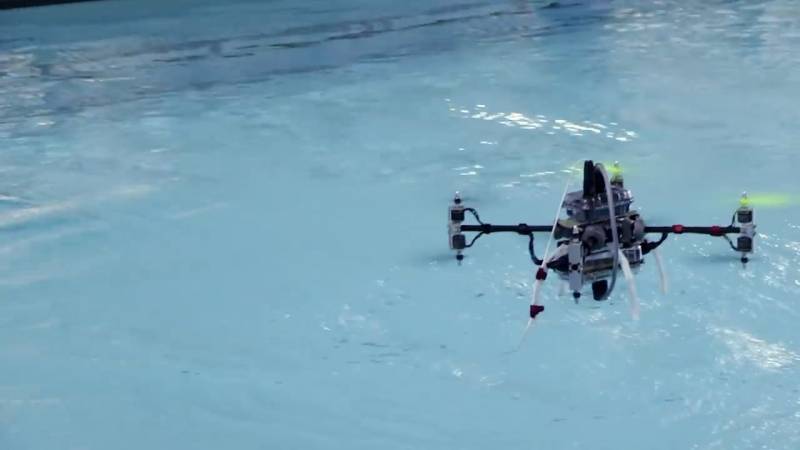
The experimental Naviator device lands on the water
The Pentagon is showing great interest in unmanned and unmanned systems of various kinds, incl. with unusual features and functions. Thus, in the near future it is planned to conduct new tests of the experimental double-medium device Naviator, capable of flying through the air and swimming under water. The purpose of these activities is to determine the military potential of such equipment and related technologies.
For air and water
The project called Naviator (literally “navigator”; it is also possible to divide into Navy and Aviator - “fleet” and “aviator”) was initially developed on an initiative basis by specialists from Rutgers University (New Jersey). In 2016, the project was taken over by the specially founded company SubUAS. At this stage, the project attracted the attention of the Office of Naval Research, which provided the necessary assistance.
Rutgers University and SubUAS began showing prototypes of the dual-medium device in 2016-17. at various Pentagon exhibitions. Development organizations also published photos and videos of their tests. The main operating modes were demonstrated - flight, swimming and transition between them.
It was then reported that the Navigator concept could find fairly wide application in the military sphere. In addition, at that time the project was already able to interest special operations forces. However, no orders or requests were received from special forces. At the same time, it cannot be ruled out that the development organization would not undertake their implementation due to the early stage of the project.
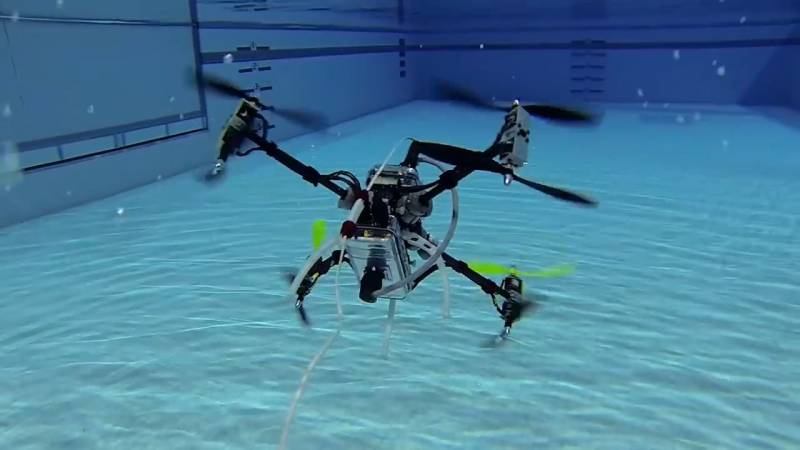
Movement underwater
Subsequently, work on the Naviator product continued. By refining the design, introducing new devices, etc. solutions increased flight characteristics in the air and performance parameters in the water. The duration of continuous operation and working depth have also been increased. The equipment was tested under different conditions, incl. in open spaces and water areas. The use of an unmanned system from various surface platforms was also tested.
New stage
The Office of Naval Research remains interested in the dual-medium complex and plans to give it new capabilities. To this end, they recently launched the Subsurface Autonomous Naviator Delivery program, during which they want to test the compatibility of the unmanned vehicle with unmanned platforms.
Development of the complex in the form of a carrier and a two-medium drone will be carried out by SubUAS with the assistance of the Naval Research Office. The corresponding contract was signed on November 8. The cost of the work was estimated at $3,7 million. The timing of the work was not specified.
Also, the technical aspects of the SAND project remain unknown. The customer and the contractor do not inform which version of the Navigator will undergo the next tests, with which underwater carrier it will be used, etc. Probably, all these details will be revealed later, as planned events take place. In addition, we should expect the first evaluations of the tests carried out and forecasts about the future of the proposed concept.
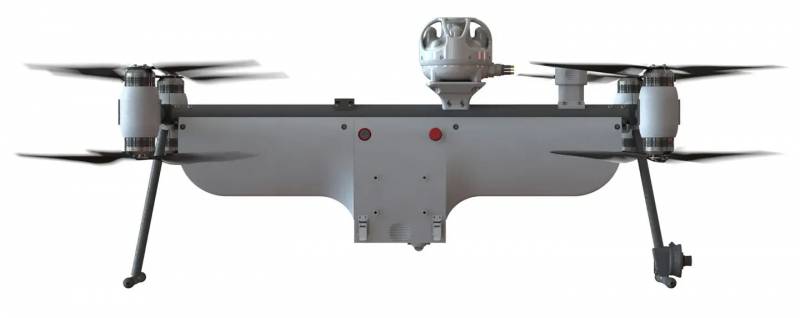
Another version of the device
Universal construction
The Naviator project offers an original concept for a dual-medium unmanned vehicle, which can be implemented in the manner required by the customer using various components and devices. Scaling is allowed, it is possible to obtain different technical characteristics, use in various fields, etc. Development organizations have already used such opportunities - a number of prototypes have been presented with different compositions of units and different parameters.
The general architecture of the Naviator devices is quite simple. Their design is similar to common quadcopter drones. There is a central body with instrumentation, on which there are “beams” with propeller-motor groups. All experimental devices of the series were equipped with eight engines and propellers. Unlike airborne UAVs, the design of the dual-medium vehicle is carefully sealed to prevent damage to electrical and electronic components.
In the air, Naviator, regardless of its design and characteristics, operates as a full-fledged quadcopter. It is capable of vertical and horizontal flight, hovering, maneuvering, etc. Communication with the operator is carried out via radio channel.
The transition to the underwater mode is carried out by simply landing on the water with the further use of propellers as propellers. In this case, the device must float “on its side” to achieve a maximum speed of about 10 knots. The presented prototypes could dive to a depth of 10 to 30 m. Instead of radio communication, a flexible cable trailing behind the device was used.
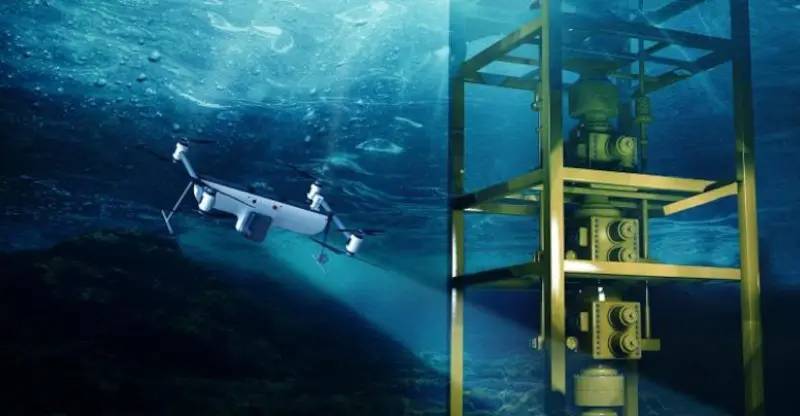
Using the device to monitor underwater conditions
A dual-medium unmanned vehicle can carry various payloads. The samples shown were equipped with video cameras in an external sealed casing. Depending on its size and other characteristics, the device may receive other equipment. In particular, the possibility of installing various sensors and even weapons is being considered.
underwater platform
In theory, "Naviator" can work from any carrier platform. It can be transported and provided with flights/swimming by cars with the necessary equipment, boats and vessels, etc. As part of the new SAND project, they plan to explore the possibility of placement on an unmanned underwater vehicle. Apparently, several main design problems will be solved.
First of all, it will be necessary to resolve the issues of basing on an underwater platform, taking into account its specifics. It is necessary to create some kind of cargo compartment for the carrier vehicle with the ability to release and return the load in an underwater and surface position, recharge batteries, etc. Special controls will also be required to link the remote operator, the underwater carrier and the dual-medium drone.
In the future, such an underwater complex is expected to find application in various fields. So, first of all, use for reconnaissance purposes is considered. The underwater vehicle will be able to secretly reach the line and release a double-medium product, which will have to rise above the water and conduct observation, make adjustments, etc.
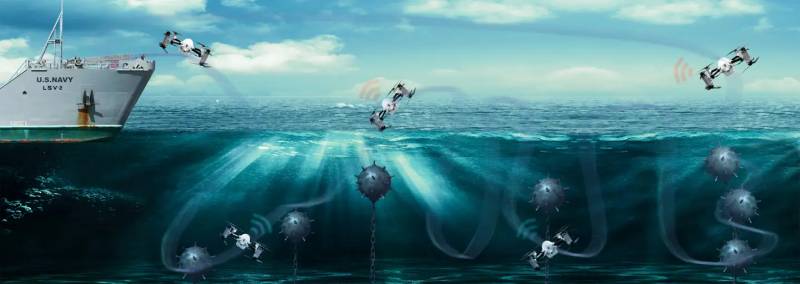
The use of "Naviator" in mine action
Naviator can also solve more complex problems. The project developers have already presented an algorithm for the operation of its mine-resistant modification. In this case, the device must operate underwater and search for dangerous objects, after which it must rise into the air and transmit data to minesweepers. Then he can return underwater and continue working until the next communication session.
In general, other options for using the double-medium technique are possible. It all depends on the needs of the operator, the platform and apparatus used, etc. It is likely that the SAND project will not only test the general capabilities, but also try to work out different application options and determine their potential.
Two environments
Thus, the Pentagon continues the process of creating and developing equipment for the naval forces. In addition to existing unmanned aerial vehicles and underwater vehicles, systems are being created to combine their capabilities. Thus, the dual-medium Naviator device has already demonstrated its main capabilities, and in several different configurations. Now he will have to go through a new stage of testing on an underwater carrier.
It is unknown what the new test program will be, and how they plan to test the complex with different unmanned vehicles. However, it is already clear what the successful implementation of these events will lead to. The “Naviator” family of equipment will receive further development, incl. according to the technical specifications of the Pentagon. In addition, plans for the development of unmanned fleets may be adjusted. And it is quite possible that dual-medium unmanned vehicles will become widespread in the future.
Information